Table of Contents

Pollock fish is not like any other seafood as it offers a delicate lean meat free of contaminants.
This fish is among the top 5 most consumed seafood products in the US alongside shrimp, salmon, tuna, and tilapia.
In this article, we gathered all the useful information you need to learn about pollock fish including its nutritional values, health benefits, the precautions you need to know before you consume a pollock fish, with tips on how to buy + cook + store it.
But first,…
What is a Pollock fish?
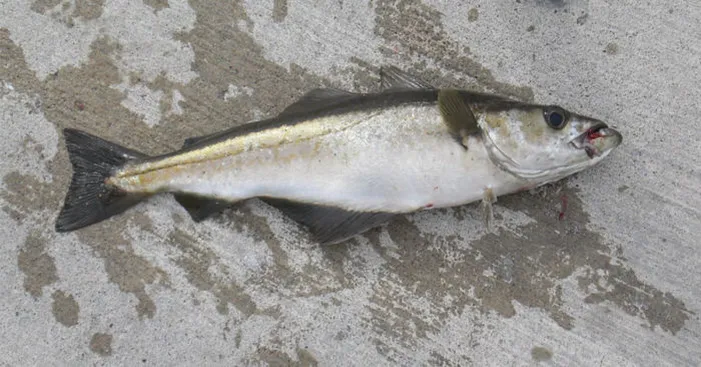
What we refer to as”Pollock fish” actually includes two different fish species “Pollachius pollachius” and “Pollachius virens”.
In the market, it is sold under the label “Alaskan pollock” because the majority of these fishes come from the Northern Pacific ocean.
However, we also use the term “coley” to refer to pollock fish, and can reach up to 3.5ft (1 m) in length and could weigh around 45lbs (20 Kg).
The Pollock fish have a white delicate meat that is very similar to salmon, light and flaky.
In the kitchen, people use the Pollock fish in many recipes such as fish sticks, fish fillets, salads, and ceviche.
Even though not many people like the taste of Pollock fish, it is still among the top 5 harvested fish species in the US.
This could be due to the good reputation this fish earned among vegetarians since they consider it a nutritionally dense fish.
Nutritional values and health benefits of the Pollock fish:

Nutritional values:
On one the things that make a pollock fish different from most types of fish is the fact that it is mercury-free!
A Pollock fish is a great source of amino acids, ascorbic acid, antioxidants, and vitamins (A, E, and B group).
In addition, the fish is full of minerals such as chromium, zinc, nickel, manganese, cobalt, and molybdenum.
With a serving size of 3oz (85g), the body gets around 500mg of omega-3 fatty acids equal to more than 40% of the daily needs.
However, the nutritional values of Pollock fish can change depending on the cooking method.
This data counts for a serving of 3oz (85g) of steamed Pollock fish:
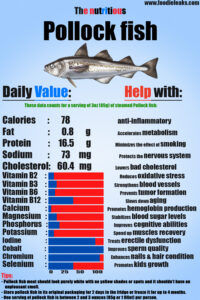
- Calories: 78
- Fat: 0.8g
- Protein: 16.5g
- Sodium: 73mg
- Cholesterol: 60.4mg
- B2 vitamin: 10%
- B3 vitamin: 15%
- B6 vitamin: 12%
- B12 vitamin: 45%
- Calcium: 5%
- Magnesium: 15%
- Phosphorus: 20%
- Potassium : 10%
- Iodine: 85%
- Cobalt: 170%
- Chromium: 93.5%
- Selenium : 45%
Health benefits:
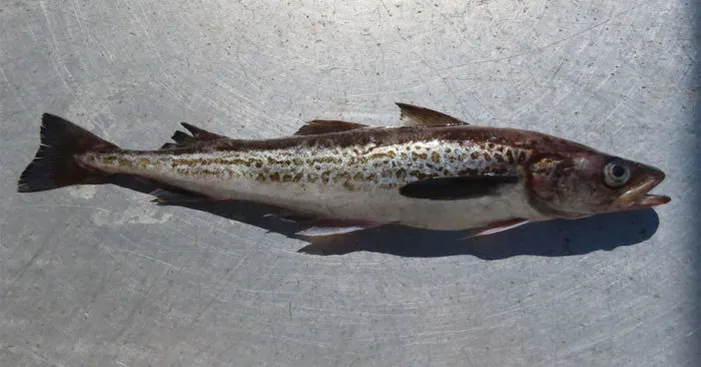
Weight loss:
Unlike other types of meat, the Pollock fish is very low in terms of caloric intake.
However, it is also a nutrient-dense food with good amounts of minerals, protein, and fatty acids.
Consuming Pollock fish as part of a weight-loss diet will ensure meeting the daily requirements for essential nutrients without too many calories.
Don’t forget that when the body gets its essential supply of essential nutrients it will have a higher metabolic rate that helps burn calories.
Good for the skin:
Being a good source of omega-3 fatty acids, pollock fish has high anti-inflammation properties.
These properties can improve the appearance of the skin since they help the body fight acne and other skin issues.
Nutritious for the hair:
Among the many benefits of B vitamins is strengthening the hair and increasing its durability.
For instance, vitamin B12 has shown great ability to treat hair loss, split ends, and dandruff.
A serving of Pollock fish provides more than 40% of your daily needs in vitamin B12 which will make your hair healthier.
Improves cognitive ability:
Pollock fish offers a combination of protein, selenium, phosphorus, and vitamin B6 which all play a key role in protecting cognitive abilities.
In fact, selenium offers great protection against free radicals the main cause of Alzheimer’s and Parkinson’s.
The other nutrients in Pollock fish are involved in the neuro-transmission process which will sharpen concentration and memory.
Lowers bad cholesterol:
The great anti-inflammation and anti-antioxidant properties of Pollock fish can reduce the effect of oxidative stress and free radicals.
This result in the breakage of plaque built up in the blood vessels and arteries essentially made from bad cholesterol.
In addition, omega-3 fatty acids in Pollock fish can also lower triglyceride (a bad LDL cholesterol) and raise HDL cholesterol levels in the body.
May prevent cancer:
Thanks to its powerful antioxidant components such as selenium and vitamin B12, Pollock fish can help reduce the risk of cancer.
Recent studies show that selenium and vitamin 12 are two powerful nutrients that can reduce the risk of prostate and colorectal cancer.
Pollock fish may even be able to reduce the risk of other types of cancer as it can eradicate free radicals before they can cause damage.
Can reduce inflammation:
Omega-3 fatty acids, Niacin, and vitamin B6 are abundant in Pollock fish and they all can reduce inflammation in the body.
The word “inflammation” may seem too general but it is the source of many health conditions such as gout, arthritis, migraines, headache, and gastrointestinal diseases.
Pollock fish health benefits for women:
This fish is very beneficial for women during menopause thanks to its omega-3 and other polyunsaturated fats.
Consuming pollock fish stabilizes the overall body metabolism and slows down aging.
In addition, these fish have a great influence on the hormonal process which is beneficial for both women and young girls undergoing puberty.
As it provides a good supply of B vitamins and iodine, Pollock fish have a good impact on the women’s nervous and endocrine systems.
In other words, consuming this fish stimulates several hormonal processes in the woman’s body which help normalize its function.
Pollock fish health benefits for kids:
While having a low fat and caloric content, Pollock fish is still a great source of complete protein which is essential for body growth.
Specialists recommend introducing toddlers from the age of 8 months to fish puree as part of additional nutrition for breastfeeding.
Other components in Pollock fish include cobalt, chromium, and iodine, which ensure that the baby is meeting the daily requirements in these trace elements.
Nonetheless, for a kid between the age of 8 months and 3 years old, it is best to offer unsated and steamed fish while making sure you take out all the bones beforehand.
You can also bake Pollock fish without additives or sauces and introduce it as part of a nutritionally dense diet for kids above the age of 1.5 years.
Pollock health benefits for men:
This protein-rich fish is very easy to digest which makes it perfect for muscle building after an intense physical workout.
The best thing about Pollock fish is that it contains minimum fats and carbs and that excludes the risks of being overweight.
Just like it is beneficial for women, the iodine content of Pollock fish ensures balanced thyroid gland functioning.
This makes it beneficial for men as well as it will maintain a stable hormonal function for men’s bodies.
As for the cobalt and chromium, this fish strengthens the immunity system and can prevent the harmful effect of free radicals that can affect the sexual system of men.
Other health benefits of Pollock fish:
- Suitable fish for people on a weight loss
- Anti-inflammatory
- Accelerates metabolism of lipids, fats, and proteins.
- Minimizes the effects of smoking.
- Prevents nervous system diseases.
- Lowers bad cholesterol levels and prevents atherosclerosis.
- Reduces oxidative stress.
- Beneficial for people with heart issues.
- Maintains thyroid gland
- Strengthens blood vessels.
- Reduces the risk of tumor formation.
- Lowers the effect of aging.
- Helps the immune system.
- Minimizes stress on the eyes.
- Prevents oral diseases.
- Helps eliminate toxins.
- Promotes hemoglobin production.
- Normalizes blood sugar levels.
- Improves cognitive abilities.
- Speed up muscle recovery and healing.
- Enhances nails and hair
- Improves sperm quality.
- Promotes better sexual health.
Consuming Pollock fish:
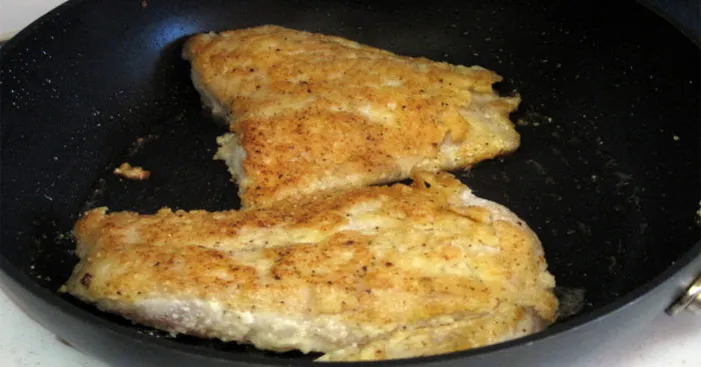
This fish is super easy to include in your diet just like you use tuna, salmon, and crab …
The best way is to steam Pollock fish or boil it in water and then add it to a few different recipes.
Here are a few ideas to inspire you to consume Pollock fish more often:
- In a sandwich.
- On pizzas.
- In a rice or pasta dish.
- With a Rice salad or a macaroni.
- As part of a special sushi recipe.
- At the end of the cooking of any soup, you can add cooked Pollock fish to add a seafood flavor to the dish.
Recipes:
Pollock fish in the oven:
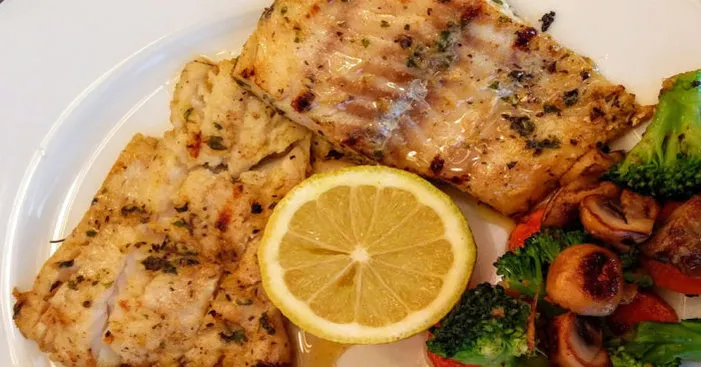
Ingredients:
- 4 pollock fillets (6 ounces, 170g).
- 2 tbsp of cooking oil.
- 2 sliced peppers.
- 2 onions are cut into rings.
- 1 tsp lemon juice.
- 1 tsp of ground pepper.
- Salt.
Preparation:
- Preheat the oven to 370°F (190°C).
- Start by washing the Pollock fillet in cold water then let it dry on a piece of cloth.
- Season the fillet with a mixture of lemon juice, salt, and pepper.
- Prepare an oven tray by covering its surface with aluminum foil and then oiling it with vegetable oil.
- Place the fillet on the tray evenly so that they don’t touch.
- Surround the fish pieces with onion rings and pepper slices, then cover the ingredients with another aluminum foil.
- Put the tray in the oven and let it bake for 30 minutes.
- Take the tray out and let it cool down then serve it and enjoy it with your loved ones.
Pollock fish with mustard sauce:
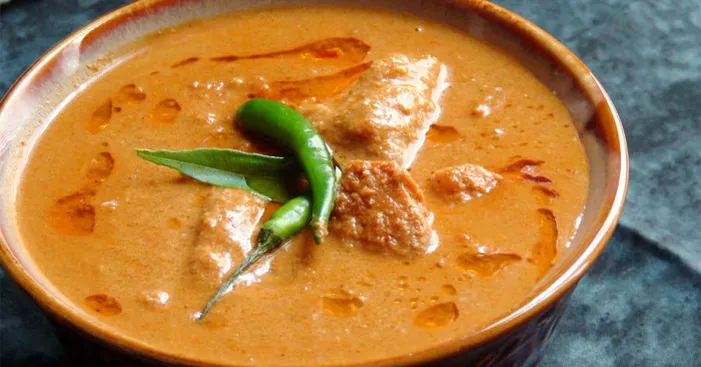
Ingredients:
- 4 pollock fillets (6 ounces, 170g).
- 4 tbsp. of olive oil.
- 3 tbsp. of flour.
- 2 tbsp. of mustard.
- 2 cups of vegetable broth.
- 1 tbsp. of lemon juice.
- A bunch of parsley.
- 1 bay leaf.
- 8 black peppercorns.
- 2 tsp of salt.
- 1 tsp of ground black pepper.
Preparation:
- In a frying pan, heat olive oil then start frying the flour while stirring for 3 minutes then add 1 cup of vegetable broth and keep stirring until it reaches boiling and the sauce starts to thicken.
- Now add mustard, salt, ground pepper, and lemon juice and stir for 2 minutes then take the pan off the heat.
- In a pan, put the Pollock fillets, chopped parsley, peppercorns, bay leaf and 1 cup of vegetable broth bring them to boil then let them cook for 5 minutes over low heat.
- Remove the pot, cover it and let it cool down for 5 minutes then drain the fish pieces.
- Place Pollock fillets on serving dishes then pour mustard sauce on top of them, you can add some chopped parsley too, enjoy it!
Precautions before you consume the Pollock fish:

As we all know, there’s almost no food that can fit everyone since what most people safely consume could cause an allergic reaction to others.
In that sense, some people suffer from seafood allergies and they should stay away from the Pollock fish as well.
The allergy symptoms may be:
- Skin rash.
- Swelling of the mouth and tongue.
- Gastrointestinal issues.
- Difficulty breathing.
- Anaphylactic reaction (needs medical intervention).
Furthermore, salted Pollock fish could create problems, especially for people diagnosed with hypertension.
Same for those who suffer from stomach ulcers or any other intestinal problems, they should eat pollock fish more than once a month.
There is also a couple of parasites that can be found in a pollock fish which is why heat treatment is necessary before eating it.
However, unlike most types of seafood, the pollock fish has the lowest level of mercury and is considered safe in terms of contamination.
Buying Pollock fish:

The good thing about Pollock fish is probably its availability as you can almost find it in the seafood part of every grocery store.
However, in order to get the most benefits from this fish, you need to learn a few buying tips.
To buy fresh Pollock fish you can follow these techniques:
- The first thing is to know where it came from, Pollock fish only lives on the northern side of the pacific.
The top producers of Pollock fish are Canada, the USA, Japan, Russia, and China.
This means that any Pollock fish that doesn’t come from these regions is most certainly not a Pollock fish.
- The second tip is the color, a Pollock fish meat should look purely white with no yellow shades or spots.
- The third tip is the smell, generally, a fresh fish shouldn’t have an unpleasant smell.
In case you are buying Pollock fish fillet, pay attention to the existence of ice which shouldn’t be covering the whole fillet pieces.
Storing Pollock fish:
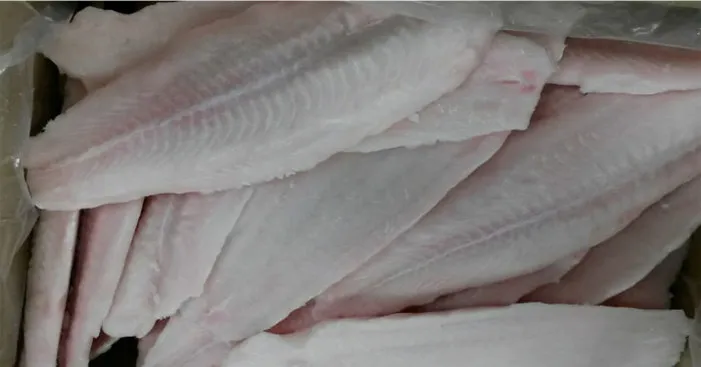
Pollock fish can be stored in the fridge in its original package for 2 days, make sure you only open the package right before usage.
To extend its lifespan, you can also freeze Pollock fish in its package and it shall retain its quality for up to 4 months.
This is different for cooked Pollock fish as it can last 4 days in the fridge and 3 months in the freezer.
Nonetheless, it is crucial to store the cooked fish no longer than 2 hours after cooking to avoid parasites and bacteria growth.
To refrigerate or freeze pollock fish you can put it in an airtight container or wrap it tightly in a plastic foil.
If you are unsure about the condition of stored Pollock fish, you can follow a few tips such as:
- Color and texture: an expired Pollock fish usually have a blatant color and slimy texture.
- Smell: if the smell of the fish is strong and unpleasant, it is most likely expired.
The expiration of the Pollock fish is due to bacteria growth which can occur if the fish is left at room temperature between 40°F and 140°F (4 to 60°C).
Because of that, you should throw away fish if it is left at room temperature for more than 2 hours as it is most likely expired.
